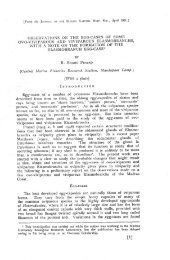PDF - Eprints@CMFRI
PDF - Eprints@CMFRI
PDF - Eprints@CMFRI
You also want an ePaper? Increase the reach of your titles
YUMPU automatically turns print PDFs into web optimized ePapers that Google loves.
149<br />
Description of RM 97: Massive, ex panding as it grows from a narrower base. Surface level. Greater<br />
diameter 17 cm, lesser 10 cm. Total height 10 cm. Corallites mono- ro trisromodaeal. Single corallites<br />
20 ro 25 mm long, 10 ro 12 mm broad, 10 ro 12 mm deep . Wall (peritheca), excluding the septa, 3 ro 5 mm<br />
thick, broader below than at the rop. Larger and smaller septa alternate, 7 ro 10 septa per cm length of<br />
valley. Larger septa 0 .75 mm thi ck, 1 ro 1.5 mm exsert, those of the opposite sides usually fuse over the<br />
wall and look continuous. On a large septum there are 6 ro 8 teeth, 1 ro 2 mm high, the uppermost vertical,<br />
tips of teeth pointed . On the thin septa there are 6 ro 10 serrations. Sides of septa smooth. Columella<br />
3 to 5 mm in diameter, composed of closely twisted trabeculae , which most of the major septa unite with.<br />
Subsidiary septa turn rowards and fuse to the sides of the major ones. Adjacent centres of columella in<br />
polycentric calices are linked by thin lacerated lamellae. Septa broader at the rop than below , a little<br />
swollen at the wall . Wall and inside of calices with endothecal vesicles. At the periphery of the coraUum<br />
co tae corresponding ro septa are visible.<br />
Mate rial:<br />
Central R. S.: HLM RM 97 (Wingate R.).<br />
Berlin 2MB 7028,7029 (Wingate R., 15 - 22 m).<br />
D is t rib uti 0 n : Red Sea. But probably more wide-spread when the synonymy is fully known .<br />
R e m a rk s : KLUNZ ING ER has stated that the species is very near ro Isophyllia spinosa of the<br />
Atlantic and West Indian waters. We have carefully compared our A. erythraea with a specimen of<br />
I. sinu osa (= I. spinosa) from West Ind ies (Xl : 155- 4 of HLM ). The major distinctions are in the t hicker<br />
wall and alternating swollen septa and larger teeth of the Red Sea species. MATIHAI (19 14) did not make<br />
any reference ro t his species, though he (1928:236) stated that Isopbyllia erythraea of KLUNZING ER is<br />
not an Isopbyllia but is more related ro Favia hirsuta (= A. echinata).<br />
There are two other species that merit considerat ion here, viz Sympbyllia simplex CROSSLAND<br />
(1948, 192 , pI. 7) and Acanthastrea billae WEL LS (1955, 15 , pI. 2, figs. 2, 3). S. simplex and A. billae<br />
are more or less the sa me. A. erytbraea seems ro differ from these mainly in the polysromodaeal nature<br />
of some of the corall ites, approach ing to a condition of Sympby llia. It is likely that all three species<br />
mentioned here constitute a single species. But more material must be certainly studied ro settle the<br />
synonymy.<br />
Genus Blastomussa WELLS, 1968<br />
T Y pes pee i e s: Bantamia merleti WELLS, 1961.<br />
G e n e r ic c h a r ae t e r s : (adapted from WEL LS, 1968) Colonial, encrusting or phaceloid with<br />
erect cylindrical branches, formed by extratentacular budding from edge zone. Septa srout, mussoid,<br />
with a low rou nded lobate rooth.<br />
HEAD (1978) divided the genus inro two subgenera, Blastomussa with phaceloid coralla and Ceriomorpba<br />
with encrusting corall a. Th e genus is known ro have three species, all three are reported from the<br />
present co ll ection.<br />
Synopsis of Blastomussa from Red Sea :<br />
A. Corallum branching, ph aceloid .<br />
1. Corallites 5 ro 7 mm in diameter. Height of branches up ro 30 mm . Septa in two complete cycles<br />
with a set of incompl ete tertiaries. . . . . . . . . . . . . . . . . . . . . . . . . . . . . . . . . . . . . . . .. B. merleti<br />
2. Corall ites 9 ro 13 mm in diameter. Branches up to 50 mm high. Septa in three complete cycles<br />
wit h an incomplete set of the fourth cycle. . ................... . .............. B. wellsi<br />
B. Corallum encrusting, cerio id .<br />
3. Calices range from 4 ro 8 mm in diameter. Corallu m often with gaps between the corallites ..... .<br />
. . . . . . . . . . . . . . . . . . . . . . . . . . . . . . . . . . . . . . . . . . . . . . . . . . . . . . . . . . . . . . . . B. loyae<br />
Blastomussa merleti (WELLS), 1961<br />
(Plate 35 , Figs. S, 6 , 10, 11 )<br />
Bantamia mer/eti 196 1. WELLS, 189; figs. 1- 4 (Type locality: New Caledonia),
















